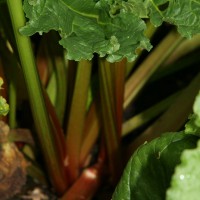How To Plant & Grow Rhubarb

Rhubarb is a reliable crop and very simple to grow. We supply our Rhubarb plants in 7cm pots; the plants can be put straight into the ground at any time of the year.
Preparation
Rhubarb prefers an open site in full sunlight, with a rich, well-drained soil. Avoid waterlogged ground. Improve soil with plenty of manure or bulky organic matter.
Planting Out
Position plants 3 x 3 ft (90 x 90 cm) apart. Keep newly planted Rhubarb well watered during dry spells, and mulch with a 3"(7 cm) layer of organic matter.
Cultivation
Keep plants weed-free, and water well in dry weather.
When growth dies down in the autumn, mulch the rhubarb crowns generously with well-rotted manure.
Apply fertiliser in late winter.
It is not unusual for rhubarb to bolt (flower) and heritage varieties tend to be more prone to this. Bolting usually occurs in warm springs. Whilst the flowers are pretty, allowing Rhubarb to bolt will drastically reduce your harvest potential (as the plant puts all its energy into forming seed) – and can even reduce the vigour of young plants to the point of death!
Be vigilant for the first signs of bolting (a swollen seed pod at the base of the plant which will then grow up atop a long shoot). To control bolting simply cut out these shoots with a sharp knife close to the crown of the plant.
Pests and Diseases
Rhubarb stalks don't tend to be eaten by slugs and snails, though they will eat the leaves. However, Rhubarb can suffer from fungal diseases such as honey fungus and crown rot, particularly if the soil is poorly drained. Plants can be saved if you act promptly to remove diseased parts of plants. Destroy the diseased parts rather than composting them to stop infection spreading. Viruses are common in Rhubarb. If plants don't thrive, dig them up and replace them.
Harvesting
Avoid harvesting Rhubarb in the first year, and only harvest lightly in the second year, to allow the plant to bulk up. Harvest Rhubarb by grasping the base of the stalk and tearing it away from the rest of the clump.
Forcing
Rhubarb Champagne and Victoria can be forced, resulting in an early crop that is sweeter and more tender, although the yield overall is smaller. We don't recommend forcing Glaskin's Perpetual, as it is too valuable as a late-season variety.
To force Rhubarb, shortly after Christmas cover the crowns with a light-excluding container with a removable lid. To ensure that light is fully excluded you can pile up organic matter or similar around the base of the container. Periodically, remove the lid from your container and check for shoots, removing the stalks when they are large enough. After approximately mid-April, uncover the crowns and allow them to grow away in the normal manner, though avoid cropping from a forced crown for a year or two in order to allow it to recover.
3 ResultsRhubarb Plant 'Champagne'
 One of the earliest varieties and recognised as one of the best for forcing. Slender pink stems are juicy and sweet. A heritage variety that is reliable and easy to grow.
One of the earliest varieties and recognised as one of the best for forcing. Slender pink stems are juicy and sweet. A heritage variety that is reliable and easy to grow.
Available Now
Supplied as a pot grown plant.
Rhubarb Plant 'Victoria'
 A tried and tested variety of Rhubarb that has proved to be reliable, with high yields of quality stalks that are green flushed red. Excellent for forcing.
A tried and tested variety of Rhubarb that has proved to be reliable, with high yields of quality stalks that are green flushed red. Excellent for forcing.
Available Now
Supplied as a pot grown plant.
Rhubarb Plant 'Glaskin's Perpetual'
 A gorgeously sweet heritage variety of Rhubarb. Can be harvested late into the season as it remains sweet. Heavy cropping and very reliable.
A gorgeously sweet heritage variety of Rhubarb. Can be harvested late into the season as it remains sweet. Heavy cropping and very reliable.
Currently Not Available To Purchase - Available from APPROXIMATELY mid May
Supplied as a pot grown plant.